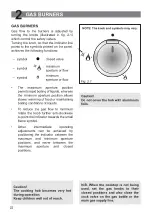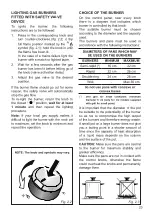
13
13
ADDITIONAL GAS CONNECTION REQUIREMENTS
When connecting the cooktop to the gas supply with rigid pipes or a flexible hose, make
sure that:
•
You use rigid pipes or a flexible hose compliant with applicable local regulations. The
flexible hose shall be of the correct construction for the type of gas being used and of
the correct size to maintain the heat output of the appliance.
•
The connection with rigid metal pipes does not cause stress or pressure to the gas
piping.
•
The flexible hose is not under tension, twisted, kinked, or too tightly bent, neither while
the cooktop is in use nor while it is being connected or disconnected.
•
The flexible hose is not longer than 2000 mm (or refer to applicable local regulations)
and does not come into contact with sharp edges, corners, or moving parts, as these
may cause abrasion. Use a single flexible hose only; never connect the cooktop with
more than one flexible hose.
•
The flexible hose can easily be inspected along its entire length to check its condition;
if it has an expiry date, it should be replaced before that date.
•
If using a flexible hose which is not entirely made of metal, make sure that it does not
come into contact with any part of the cooktop with a surface temperature of 70°C or
above (or refer to applicable local regulations).
•
The rigid pipe or flexible hose is replaced if it shows signs of damage.
•
The flexible hose is not subject to excessive heat by direct exposure to flue products
or by contact with hot surfaces.
•
The socket into which the plug of the flexible hose fit is permanently attached to a firmly
fixed gas installation pipe and is positioned so that the hose hangs freely downwards.
•
The plug of the flexible hose is accessible after installation, so that it can be
disconnected for service or removal.
•
You inform the customer that the rigid pipe or flexible hose should not be subjected to
corrosion by cleaning agents.
Содержание CHW32X LPG
Страница 18: ...18 18...
Страница 19: ...19 19 Advice for the users...
Страница 27: ...27 27 Fig 3 1 Fig 3 2 Fig 3 3 Fig 3 4 Fig 3 5 S F C T A B S T...














































